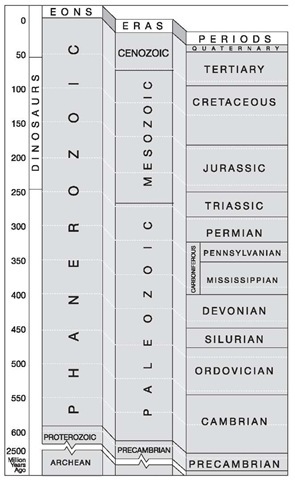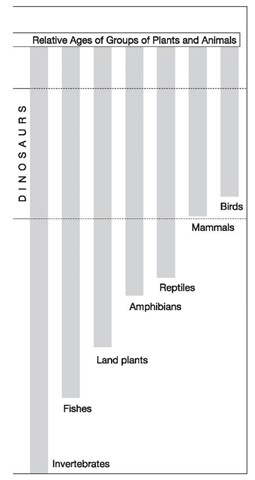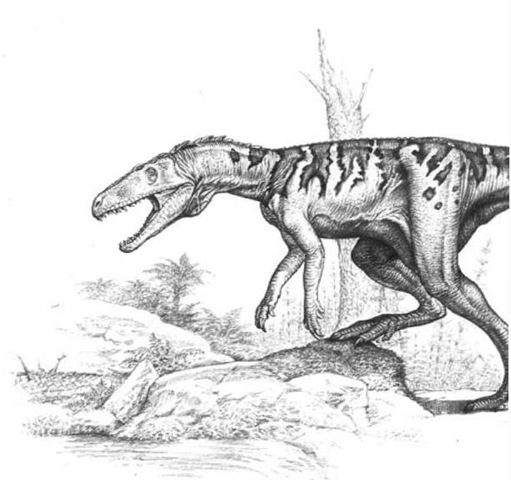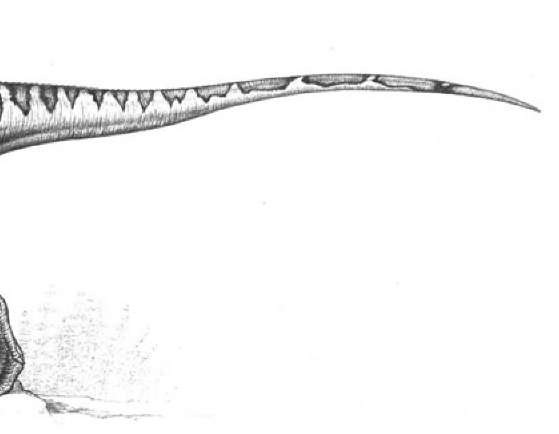The fossilized remains of dinosaurs (with the notable exception of their lineal descendants the birds – see topic 6) have been found in rocks identified as belonging to the Mesozoic Era. Mesozoic rocks range in age from 245 to 65 million years ago (abbreviated to Ma from now on). In order to put the time during which dinosaurs lived into context, since such numbers are so large as to be quite literally unimaginable, it is simpler to refer the reader to the geological timescale (Figure 4).
During the 19th and a considerable part of the 20th centuries, the age of the Earth, and the relative ages of the different rocks of which it is composed, had been the subject of intense scrutiny. During the early part of the 19th century it was becoming recognized (though not without dispute) that the rocks of the Earth, and the fossils that they contained, could be divided into qualitatively different types. There were rocks that appeared to contain no fossils (often referred to as igneous, or ‘basement’). Positioned above these apparently lifeless basement rocks was a sequence of four types of rocks that signified four ages of the Earth. During much of the 19th century these were named Primary, Secondary, Tertiary, and Quaternary -quite literally the first, second, third, and fourth ages. The ones that contained traces of ancient shelled and simple fish-like creatures were ‘Primary’ (now more commonly called Palaeozoic, literally indicative of ‘ancient life’). Above the palaeozoics was a sequence of rocks that contained a combination of shells, fish, and land-living saurians (or ‘crawlers’, which today would include amphibians and reptiles); these rocks were designated broadly as ‘Secondary’ (nowadays Mesozoic, ‘middle life’). Above the mesozoics were found rocks that contain creatures more similar to those living today, notably because they include mammals and birds; these were named ‘Tertiary’ (now also called Cenozoic, ‘recent life’). And finally, there was the ‘Quaternary’ (or Recent) that charted the appearance of recognizably modern plants and animals and the influence of the great ice ages.
This general pattern has stood the test of time remarkably well. All modern geological timescales continue to recognize these relatively crude, but fundamental, subdivisions: Paleozoic, Mesozoic, Cenozoic, Recent. However, refinements in the way the fossil record can be examined for example, through the use of high-resolution microscopy, the identification of chemical signatures associated with life, and the more accurate dating of rocks enabled by radioactive isotope techniques have led to a more precise timescale of Earth history.
The part of the timescale that we are most concerned with in this topic is the Mesozoic Era, comprising three geological periods: the Triassic (245-200 Ma), the Jurassic (200-144 Ma), and the Cretaceous (144-65 Ma). Note that these periods of time are not by any means equal in duration. Geologists were not able to identify a metronome-like tick of the clock measuring the passing of Earth time. The boundaries between the periods were mapped out in the last two centuries by geologists who were able to define particular rock types and, very often, their constituent fossils, and this is usually reflected in the names chosen for the periods. The term ‘Triassic’ originates from a triplet of distinctive rock types (known as the Lias, Malm, and Dogger); the ‘Jurassic’ hails from a sequence of rocks identified in the Jura Mountains of France; while the name ‘Cretaceous’ was chosen to reflect the great thickness of chalk (known as Kreta in Greek) such as that which forms the White Cliffs of Dover and is found widely across Eurasia and North America.
4. The geological timescale puts into context the period during which the dinosaurs lived on Earth
The earliest dinosaurs known have been identified in rocks dated at 225 Ma, from the close of the Triassic (a period known as the Carnian), in Argentina and Madagascar. Rather disconcertingly, these earliest remains are not rare, solitary examples of one type of creature: the common ancestor of all later dinosaurs. To date at least four, possibly five, different creatures have been identified: three meat-eaters (Eoraptor, Herrerasaurus, and Staurikosaurus), a tantalizingly incomplete plant-eater named Pisanosaurus, and an as-yet-unnamed omnivore. One conclusion is obvious: these are not the earliest dinosaurs. In the Carnian there was clearly a diversity of early dinosaurs. This indicates that there must have been dinosaurs living in the Middle Triassic (Ladinian-Anisian) that had ‘fathered’ the Carnian diversity. So we know for a fact that the story of dinosaur origins, both the time and the place, is incomplete.
Why dinosaur fossils are rare
It is important, at the outset, for the reader to realize that the fossil record is incomplete and, perhaps more worryingly, decidedly patchy. The incompleteness is a product of the process of fossilization. Dinosaurs were all land-living (terrestrial) animals, which poses particular problems. To appreciate this, it is necessary first to consider the case of a shelled creature living in the sea, such as an oyster. In the shallow seas where oysters live today, their fossilization potential is quite high. They are living on, or attached to, the seabed and are subjected to a constant ‘drizzle’ of small particles (sediment), including decaying planktonic organisms, silt or mud, and sand grains. If an oyster should die, its soft tissues would rot or be scavenged by other organisms quite quickly and its hard shell would be gradually buried under fine sediment. Once buried, the shell has the potential to become a fossil as it becomes trapped under an increasingly thick layer of sediment. Over thousands or millions of years, the sediment in which the shell was buried is gradually compressed to form a silty sandstone, and this may become cemented or lithified (literally, turned to stone) by the deposition of calcium carbonate (calcite) or silica (chert/flint) carried through the fabric of the rock by percolating water. For the fossil remains of the original oyster to be discovered, the deeply buried rock would need to be lifted, by earth movements, to form dry land, and then subjected to the normal processes of weathering and erosion.
5. The meat-eating dinosaur Herrerasaurus
Land-living creatures, by contrast, have a far lower probability of becoming fossilized. Any animal dying on land is likely, of course, to have its soft, fleshy remains scavenged and recycled; however, for such a creature to be preserved as a fossil it would need to be subject to some form of burial. In rare circumstances creatures may be buried rapidly in drifting dune sand, a mud-slide, under volcanic ash, or some by other catastrophic event. However, in the majority of cases the remains of land animals need to be washed into a nearby stream or river, and eventually find their way into a lake or seabed where the process of slow burial, leading to fossilization, can commence. In simple, probabilistic terms the pathway to fossilization for any land creature is that much longer, and fraught with greater hazard. Many animals that die on land are scavenged and their remains become entirely scattered so that even their hard parts are recycled into the biosphere; others have their skeletons scattered, so that only broken fragments actually complete the path to eventual burial, leaving tantalizing glimpses of creatures; only very rarely will major parts, or even whole skeletons, be preserved in their entirety.
So, logic dictates that dinosaur skeletons (as with any land-living animal) should be extremely rare and so they are, despite the impression sometimes given by the media.
The discovery of dinosaurs and their appearance within the fossil record is also a decidedly patchy business, for rather mundane reasons. Fossil preservation is, as we have just come to appreciate, a chance-laden, rather than design-driven, process.
The relatively brittle surface layers of the Earth (its crust, in geological terms) have been buckled, torn, and crumpled by huge geological forces acting over tens or hundreds of millions of years that have wrenched landmasses apart or crushed them together. As a result, the geological strata containing fossils have been broken, thrown up, and frequently destroyed completely by the process of erosion throughout geological time, and further confused by later periods of renewed sedimentation. What we, as palaeontologists, are left with is an extremely complex ‘battlefield’, pitted, cratered, and broken in a bewildering variety of ways. Disentangling this ‘mess’ has been the work of countless generations of field geologists. Outcrops here, cliff-sections there, have been studied and slowly assembled into the jigsaw that is the geological structure of the land. As a result, it is now possible to identify rocks of Mesozoic age (belonging to the Triassic, Jurassic, and Cretaceous Periods) with some accuracy in any country in the world. However, that is not sufficient to aid the search for dinosaurs. It is also necessary to disregard Mesozoic rocks laid down on the sea floor, such as the thick chalk deposits of the Cretaceous and the abundant limestones of the Jurassic. The best types of rocks to search in for dinosaur fossils are those that were laid down as shallow coastal or estuarine environments; these might have trapped the odd, bloated carcasses of land-living creatures washed out to sea. But best of all are river and lake sediments, environments that were physically much closer to the source of land creatures.
Searching for dinosaurs
From the very outset, we need to approach the search for dinosaurs systematically. On the basis of what we have learned so far, it is first necessary to check where to find rocks of the appropriate age by consulting geological maps of the country that is of interest. It is equally important to ensure that the rocks are of a type that is at least likely to preserve the remains of land animals; so some geological knowledge is required in order to predict the likelihood of finding dinosaur fossils, especially when visiting an area for the first time.
Mostly, this involves developing a familiarity with rocks and their appearance in the area being investigated; this is rather similar to the way in which a hunter needs to study intently the terrain in which the prey lives. It also requires the development of an ‘eye’ for fossils, which comes simply from looking until fossil fragments are eventually recognized, and this takes time.
Discovery provides the adrenaline-rush of excitement, but is also the time when the discoverer needs to be most circumspect. All too often fossil discoveries have been ruined, scientifically speaking, in the frantic rush to dig the specimen up, so that it can be displayed by its proud finder. Such impatience can result in great damage to the fossil itself. Even worse, the object might be part of a larger skeleton that might be far more profitably excavated carefully by a larger team of trained palaeontologists. And, as the sleuth might point out, the rocks in which the fossil was embedded may also have important tales to tell concerning the circumstances under which the animal died and was buried, in addition to the more obvious information concerning the actual geological age of the specimen.
The search for, and discovery of, fossils can be a personally exciting adventure as well as a technically fascinating process. However, finding fossils is just the beginning of a process of scientific investigation that can lead to an understanding of the biology and way of life of the fossilized creature and the world in which it once lived. In this latter respect, the science of palaeontology exhibits some similarities to the work of the forensic pathologist: both clearly share an intense interest in understanding the circumstances surrounding the discovery of a body, and use science to interpret and understand as many of the clues as possible in an effort to leave, quite literally, no stone unturned.




